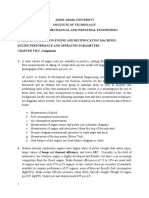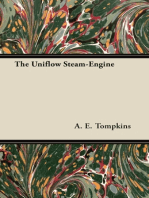Tutorial 5 Internal Combustion Engine BDA 3043 - Thermodynamics II Winardi Sani
Uploaded by
wanpudinTutorial 5 Internal Combustion Engine BDA 3043 - Thermodynamics II Winardi Sani
Uploaded by
wanpudinJabatan Kejuruteraan Loji dan Automotif Fakulti Kejuruteraan Mekanikal dan Pembuatan Universiti Tun Hussein Onn Malaysia
Tutorial 5 Internal Combustion Engine BDA 3043 Thermodynamics II Winardi Sani
Calculate the ideal air standard cycle efciency based on the Otto cycle for a petrol engine with a cylinder bore of 50 mm, a stroke of 75 mm, and a clearance volume of 21.3 cm3 . Ideal Diesel cycle (a) Show that the thermal efciency of the Diesel engine can be expressed as: th,Diesel = 1 With r =
V1 V2 , rc
1 r1
1 rc (rc 1)
V3 V2
as compression ratio and cutoff ratio, respectively.
(b) Plot th = th (r) for rc = 1, rc = 2 and rc = 3, = 1.4.
A diesel engine has an inlet temperature and pressure of 15 C and 1 bar, respectively. The compression ratio is 12/1 anf the maximum cycle temperature is 1100 C. Calculate the air standard thermal efciency based on the diesel cycle. An oil engine takes in air at 1.013 bar, 20 C and the maximum cycle pressure is 69 bar. The compressor ratio is 18/1. Based on the dual-combustion cycle and assuming that the heat added at constant volume is equal to the heat added at constant pressure, calculate (a) the air standard thermal efciency (b) Mean effective pressure for the cycle
A four-cylinder petrol engine has a bore of 57 mm and a stroke of 90 mm. Its rated speed is 2800 rev/min, and it is tested at this speed against a brake which has a torque arm of 0.356 m. The net brake load is 155 N and the fuel consumption is 6.74 ltr/h. The specic gravity of the petrol used is 0.735 and it has a lower specic caloric value Qnet,v of 44,200 kJ/kg. A Morse test is carried out and the cylinders are cut out in the order 1, 2, 3, 4 with corresponding brake loads of 111, 106.5, 104.2, and 111 N, respectively. For this speed calculate: (a) the engine torque, the bmep, the brake thermal efciency (b) the specic fuel consumption, the mechanical efciency (c) the imep (d) Estimate the volumetric efciency of the engine, if the engine is tested in an atmosphere at 1.013 bar and 15 C.
You might also like
- ME 416 (ME 4) Internal Combustion Engine Practice ProblemsNo ratings yetME 416 (ME 4) Internal Combustion Engine Practice Problems3 pages
- Assignment2 - 110006 - Elements of Mechenical Engineering0% (1)Assignment2 - 110006 - Elements of Mechenical Engineering6 pages
- Fourth Year - Mechanical Power Eng. Dept. First Term - 2016/2017 Internal Combustion EnginesNo ratings yetFourth Year - Mechanical Power Eng. Dept. First Term - 2016/2017 Internal Combustion Engines5 pages
- Comsats Institute of Information Technology SahiwalNo ratings yetComsats Institute of Information Technology Sahiwal2 pages
- ME 525 April 17, 2020 Internal Combustion Engine Performance Problems Set 1 InstructionsNo ratings yetME 525 April 17, 2020 Internal Combustion Engine Performance Problems Set 1 Instructions2 pages
- Applied Thermodynamics Unit-Ic Engines Assaignment - 01: Bharath .A, Lecturer, Dsce, Bangalore0% (1)Applied Thermodynamics Unit-Ic Engines Assaignment - 01: Bharath .A, Lecturer, Dsce, Bangalore4 pages
- Glue Marking 26 Pcs 4.75% Patches of Paint:5 Pcs 0.91%: QIS Section Have Been Found Defect On Part Surface Such AsNo ratings yetGlue Marking 26 Pcs 4.75% Patches of Paint:5 Pcs 0.91%: QIS Section Have Been Found Defect On Part Surface Such As1 page
- Bearing Stage Doreamon: 1. The Bearing Hole Still Failed at The Go Gauge, The Gauge Can't Touch The End of The HoldNo ratings yetBearing Stage Doreamon: 1. The Bearing Hole Still Failed at The Go Gauge, The Gauge Can't Touch The End of The Hold2 pages
- Nakazawa Die Casting Badminton Tournament 2016: Logo Logo DepanNo ratings yetNakazawa Die Casting Badminton Tournament 2016: Logo Logo Depan1 page
- No Cop OK From QA Barrel (After Air Blast)No ratings yetNo Cop OK From QA Barrel (After Air Blast)2 pages














































































